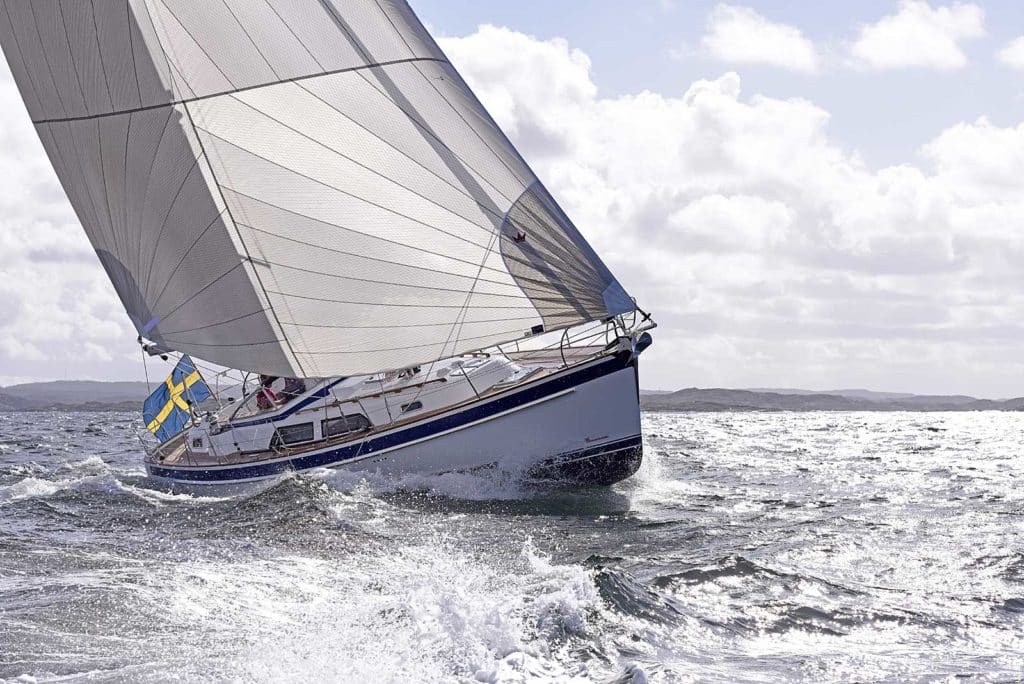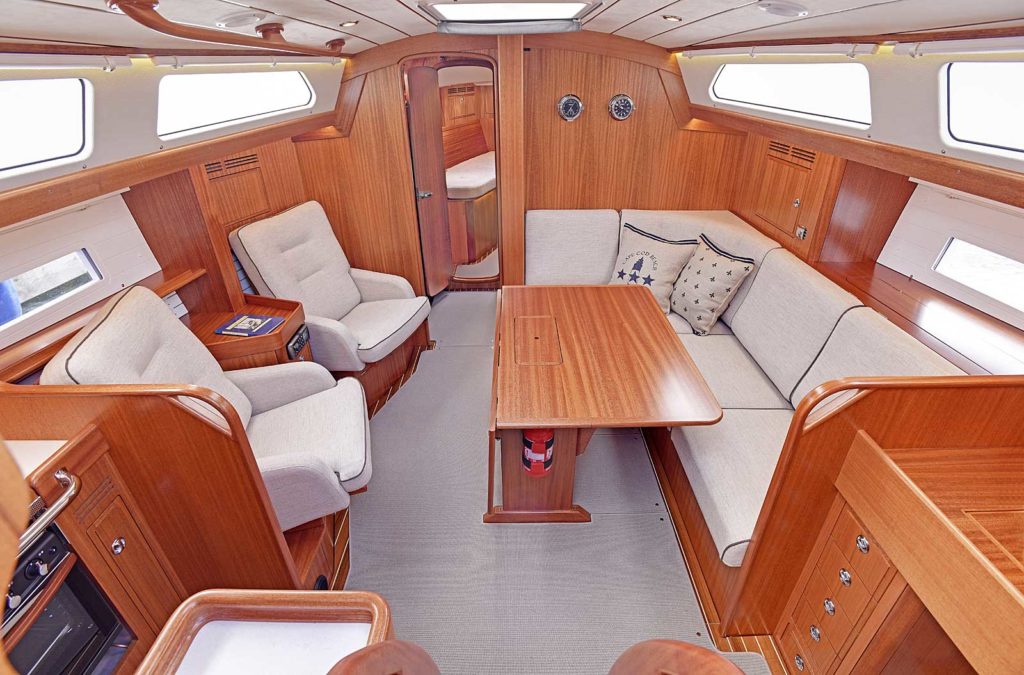
Naval architect Germán Frers is normally associated with top-of-the-line racing and cruising yachts, not mid-cockpit cruisers. But he’s designed every Hallberg-Rassy since 1988, and his influence on the HR 40 is apparent in its performance, for the 40 is an efficient passagemaker in a range of wind angles and strengths.
Cruising World’s Boat of the Year team sailed her in light conditions (6 to 8 knots) on Chesapeake Bay last fall and were impressed with both her handling and the easy accessibility of all sailhandling controls from the helm. In those light airs, with just the mainsail up, her fin-keeled underbody ensured that she maneuvered smartly through the eye of the wind-something not every cruising boat will do.
The HR 40 is characterized by the distinctive Hallberg-Rassy fixed windshield with integrated folding dodger. Teak decks, coamings, and caprails (on the bulwarks) are standard. The cockpit, with its high backrests and teak sole grating, is comfortable and seamanlike, but it isn’t overly large, which is a good thing from the standpoints of headroom below and safety on deck. The steering pedestal includes engine instruments, a single-lever control, and a varnished teak folding table. Raymarine ST60 instrumentation for depth, boat speed, and wind speed and direction is mounted above the companionway.
The deck-stepped double-spreader mast is supported by oversized standing rigging with double lower shrouds running to real chainplates on glassed-in bulkheads. A conventional mainsail with two reefs, plus a working jib-providing 869 square feet of sail-is the standard plan, but in-mast roller furling is optional.
The genoa-track cars are adjustable from the cockpit. Sheets are handled by Lewmar No. 50 self-tailing winches with power an option. Halyards run to mast-mounted winches, bucking the trend to running them aft. The mainsheet, which runs from the end of the boom with only a 2:1 purchase, runs to Lewmar No. 30 self-tailing winches outboard of the helm.
To distribute keel and mast-step loads, a well-engineered grid system is laminated into the hull, which is laid up by hand using isophthalic polyester gelcoat and resin. Divinycell PVC foam core is used above the waterline. Decks are also cored with Divinycell, with reinforcements at hardware locations. Hulls and decks are glassed together before the installation of any tanks or machinery. While not as labor- or cost-efficient, this practice assures that anything that needs to be replaced will fit through the companionway.
The interior is varnished mahogany with nicely crafted curved laminations in both the trim and structural components. The teak-and-holly sole is carpeted for protection. The saloon has an L-shaped settee and a table to starboard, with either a settee/sea berth or two seagoing armchairs to port.

The galley has a two-burner propane stove/oven with a stainless-steel protective rail. Twelve-volt refrigeration is standard; a freezer is optional. Opposite the galley, the chart table has adequate space for electronic installations. Aft of the chart table is a large head, the only one aboard, which has a stall shower with a teak grating. All shower water is pumped directly overboard and never into the bilge. The stainless-steel holding tank has a gravity drain.
The starboard walk-through to the aft cabin has doors to a large engine space. However, better access to the forward part of the engine would facilitate belt changing. The aft cabin can be configured with full mattresses to port and starboard or as an island queen-size berth with access from both sides. A traditional V-berth is forward. Lewmar extruded-aluminum deck hatches and opening ports provide fine ventilation below. Locker ventilation from above is also excellent.
The 55-horsepower, 4-cylinder Volvo D2-55 diesel is installed with a 107-gallon fuel tank. The engine has a 60-amp alternator to charge the 62-amp-hour starting battery and two 140-amp-hour house batteries. Interior lighting is halogen for low electrical consumption. Probably because these boats are built near 60 degrees north latitude, a Webasto diesel heating system is standard.
Hallberg-Rassy 40 Specs
LOA: 40′ 8″ (12.40 m.)
LWL: 37′ 10″ (11.52 m.)
Beam: 12′ 6″ (3.82 m.)
Draft: 6′ 7″ (1.99 m.) Shallow-draft version available
Sail Area (100%): 869 sq. ft. (80.8 sq. m.)
Displacement: 22,000 lb. (9,988 kg.)
Water: 98 gal. (370 l.)
Fuel: 107 gal. (400 l.)
Designer: Germán Frers
Price: $400,000
Hallberg-Rassy
(860) 767-8224
www.hallberg-rassy.com








